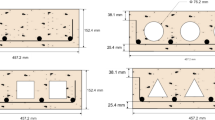Abstract
This study presents an optimal angle and a topology extraction of diagonal members in a DiaGrid structural system for tall buildings. The angle and topology of diagonal members are achieved by using a computer-oriented SIMP topology optimization. The objective function for the design optimization is to both maximize Eigenfrequency for resisting dynamic responses and minimize mean compliance for static responses. Relative densities subjected to SIMP penalty law are used for both optimization design variables and material properties, and then finite element analysis is carried out by using the relative element density. Frequency and mean compliance sensitivities with respect to relative density are straightforwardly derived by discrete sensitivity formulations. Based on the design sensitivity analysis, an initial topology with a given fixed support is shifted toward a final topology charged by almost voids (0) and solids (1) during every optimization procedure. An optimal DiaGrid topology with the highest stiffness is finally determined to resist both static and dynamic behaviors. Numerical examples with varied fixed support models are studied to find out optimal angles and topologies of diagonal members for a DiaGrid system design.
Similar content being viewed by others
References
Bendsøe, M. P. (1989). “Optimal shape design as a material distribution problem.”Structural Optimization, 1, 193–202.
Bendsøe, M. P. (1995).Optimization of Structural Topology, Shape, and Material. Springer, Berlin, Heidelberg.
Munro, D. (2004). “Swiss Re’s Building, London.”Nyheter Stålbyggnad, 3, 36–43.
Diaz, A. R. and Kikuchi, N. (1992). “Solutions to shape and topology eigenvalue optimization problems using a homogenization method.”International Journal for Numerical Methods in Engineering, 35, 1487–1502.
Edward, B. M., Shapour, A., Balakumar, B., James, D., Keith, H., and Gregory, W. (2000).An Engineer’s Guide to MATLAB. Prentice Hall, Upper Saddle River, NJ.
Genduso, B. (2004).Structural Redesign of a Perimeter Diagrid Lateral System. Senior Thesis, Architectural Engineering, Penn State University.
Gerard, L. G. S. and Henk, A. V. (1996). “A Jacobi-Davidon Iteration Method for Linear Eigenvalue Problems.”SIAM J. Matrix Anal. Appl., 17(2), pp. 401–425.
Haug, E. J., Choi, K. K., and Komkov, V. (1986).Design Sensitivity Analysis of Structural Systems. Academic Press, Orlando, New York.
Krog, L. A. and Olhoff, N. (1999). “Optimum topology and reinforcement design of disk and plate structures with multiple stiffness and eigenfrequency objectives.”Computers and Structures, 72, 535–563.
Leonard, J. (2007).Investigation of Shear Lag Effect in High-rise Buildings with Diagrid System. MS.c Thesis, Massachusetts Institute of Technology.
Moon, K. S., Conner, J. J., and Fernandez, J. E. (2007). “Diagrid structural systems for tall buildings: characteristics and methodology for preliminary design.”The Structural Design of Tall and Special Buildings, 16(2), pp. 205–230.
Neves, M. M., Rodrigues, H., and Guedes, J. M. (1995). “Generalized topology design of structures with a buckling load criterion.”Structural Optimization, 10, 71–78.
Pedersen, N. L. (2000). “Maximization of eigenvalues using topology optimization.”Structural and Multidisciplinary Optimization, 20, 2–11.
Rahimian, A. and Eilon, Y. (2006). “New York’s Hearst Tower-A restoration, an adaptive reuse and a modern steel tower rolled into one.”Structure Magazine, pp. 25–29.
Sigmund, O. (2001). “A 99 topology optimization code written in Matlab.”Structural and Multidisciplinary Optimization, 21, 120–127.
Subramanian, G. and Subramanian, N. (1970). “Analysis of simply-supported uniform diagrids.”Building Science, 4, 209–215.
Svanberg, K. (1987). “The method of moving asymptotes-a new method for structural optimization.”International Journal for Numerical Methods in Engineering, 24, 359–373.
Youn, S. K. and Park, S. H. (1997). “A Study on the shape extraction process in the structural topology optimization using homogenization material.”Computers and Structures, 62(3), pp. 527–538.
Author information
Authors and Affiliations
Corresponding author
Rights and permissions
About this article
Cite this article
Lee, DK., Starossek, U. & Shin, SM. Optimized topology extraction of steel-framed DiaGrid structure for tall buildings. International Journal of Steel Structures 10, 157–164 (2010). https://doi.org/10.1007/BF03215827
Received:
Accepted:
Issue Date:
DOI: https://doi.org/10.1007/BF03215827




